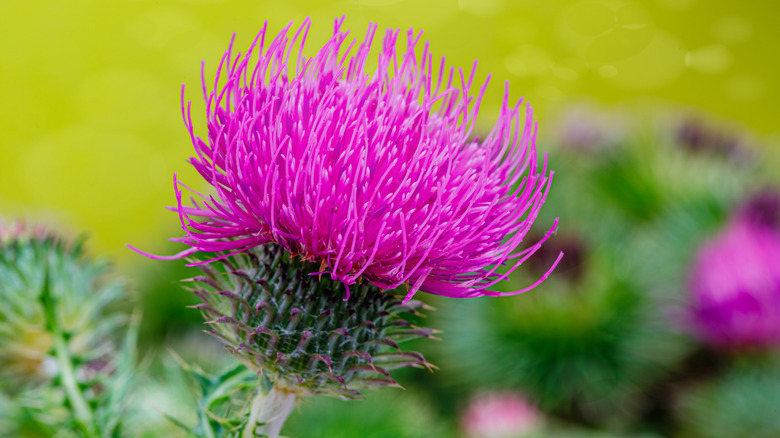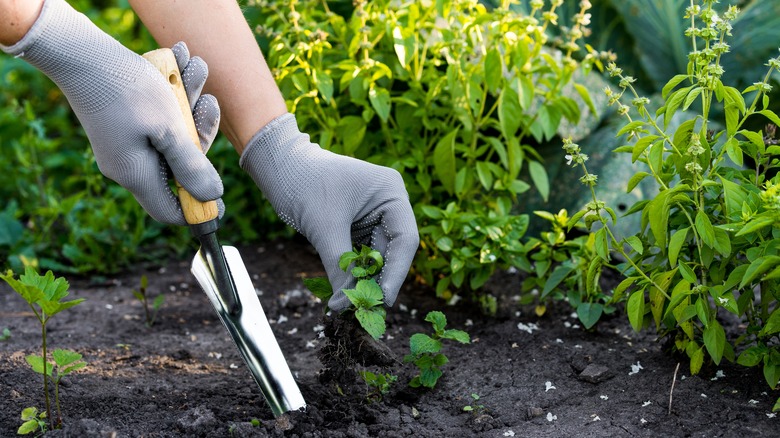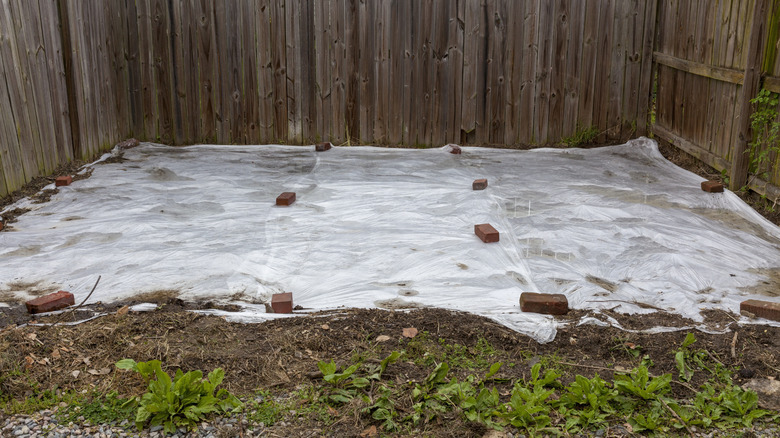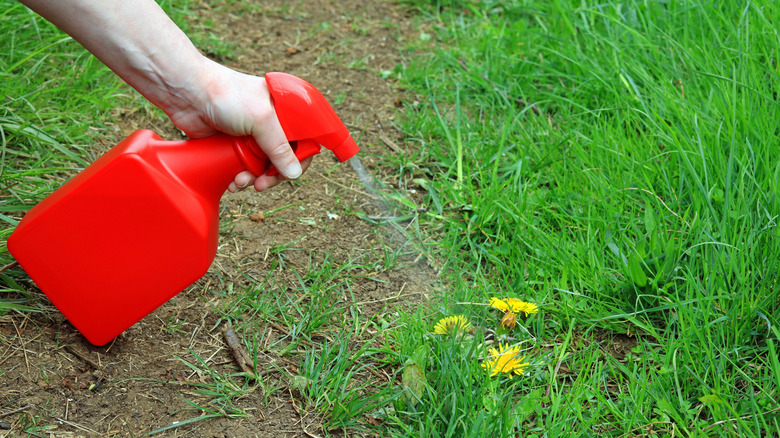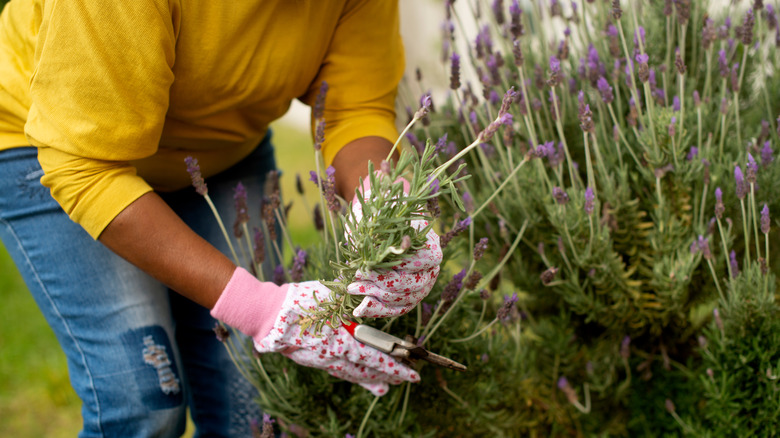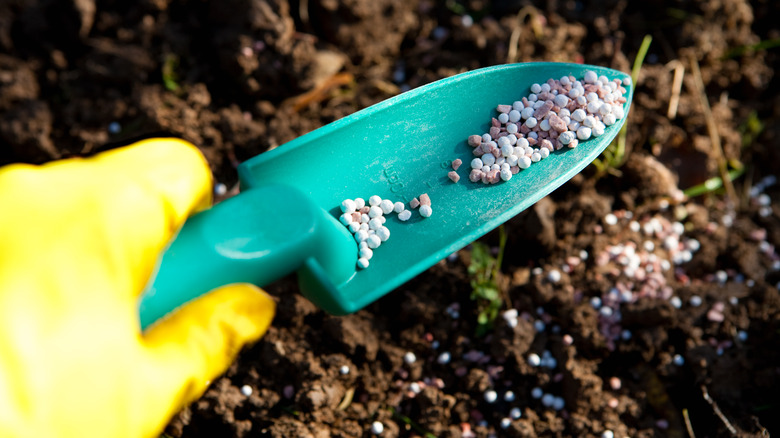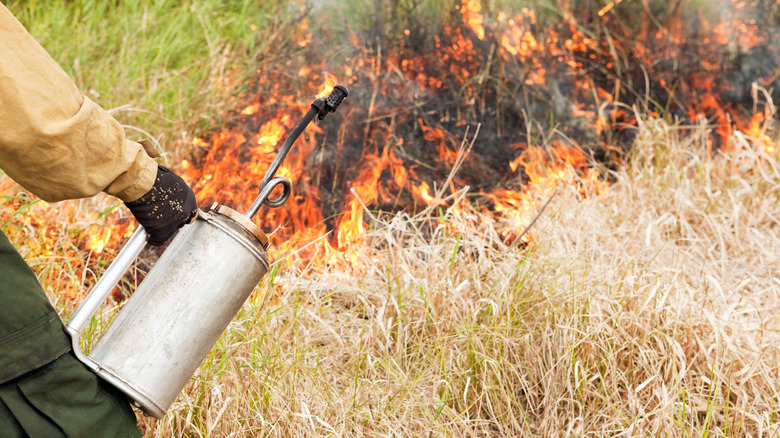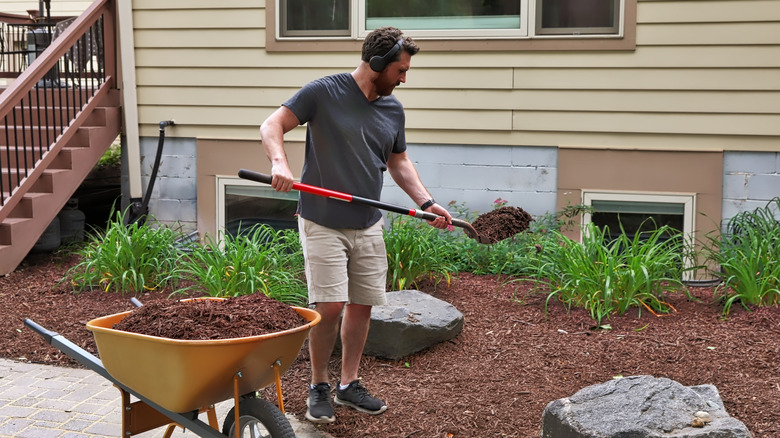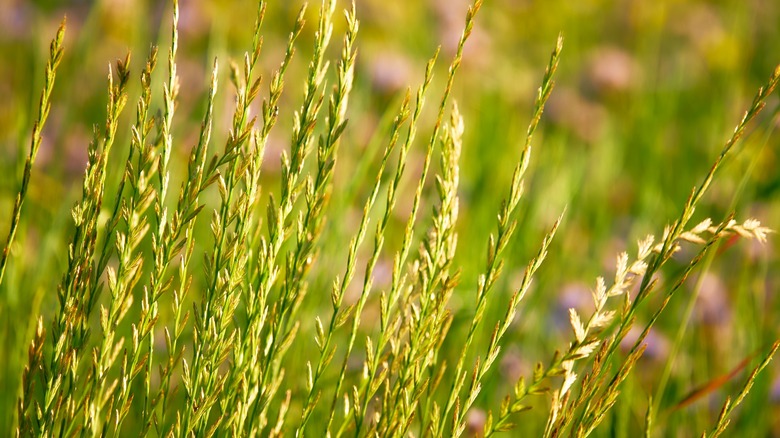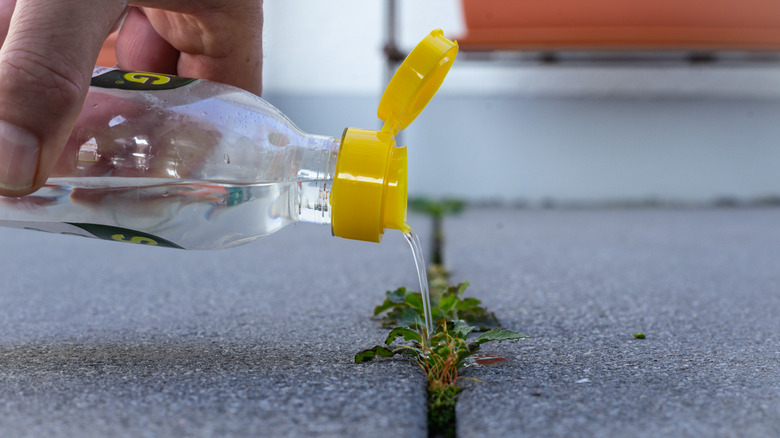12 Ways To Banish Thistle Weeds From Your Yard
When it comes to invasive weeds that can be difficult to remove, a few thistle species rise to the top of the list. According to the Xerces Society, North America is home to 62 different thistle species; however, not all of these are classified as invasive. Canada, bull, and musk thistles are three of the most problematic thistle weeds, as they can quickly take over a garden or pasture and outcompete desirable flowers and crops. As soon as you spot thistles growing on your property, you'll need to take immediate action to achieve full control.
In order to successfully eradicate thistle weeds from your yard, you will need to implement a few different control strategies, as one method often isn't enough. This makes sense when you realize that thistles are able to produce between 8,000 and 120,000 seeds per plant during the growing season (via Mississippi State University). If you're dealing with a perennial thistle, such as the Canada thistle, then you also have to consider the weed's roots, as both the roots and seeds are able to cause spread. Banishing thistle weeds is possible with a plan that includes multiple attack strategies, so grab a pair of gloves and prepare yourself for battle.
Use garden tools to dig the weeds out by hand
As long as you're dealing with a few small thistle patches, you can take care of them using basic gardening tools. Gardening trowels and spades will help you dig into the soil to remove the problematic weeds, but you will need to wear thick gloves for protection, as thistles are prickly. Before you begin, it's important to note whether you are dealing with biennial or perennial species. With biennial thistles, you can leave roots behind without the worry of spread. Perennial thistles will continue to plague your garden if you don't remove the entire plant, including the roots.
If the thistle patch you're working with falls into the biennial category, grab the gardening tool of your choice and dig down 10 centimeters into the soil. Cut the weeds and then lift them up and out of the soil. This is best done while the weeds are still young and before they have had a chance to start flowering. Immediately place the thistles in a garbage bag to dispose of them. For perennial thistles, you'll need to dig down until you've exposed the weeds' entire root system. Dig around the roots to remove the thistles, being sure not to leave any pieces behind.
Harness the power of the sun to kill thistle weeds
Another option to combat thistles from your yard is to let the sun do all the work for you. Solarization and occultation use the power of the sun to heat up the soil and prevent it from receiving water. As a result, weeds and other vegetation are killed off. The University of Minnesota Extension recommends doing this at the end of the summer when you'd like to prepare the ground for a new crop. Since this method of banishing weeds also kills other plants, you'll want to make sure you only use it where patches of thistles exist.
Decide whether you'd like to go with solarization or occultation. Solarization requires the use of clear plastic sheeting with a thickness between 2 and 6 mil, which you can find at any Home Depot or other home improvement store. Occultation utilizes a roll of black sheeting with a thickness of at least 6 mil. Both options will work. Solarization works a bit more quickly, however, occultation tarps are less likely to rip, which means you'll be able to use them more than once. When you lay the sheeting over the thistles, make sure you weigh the corners down with a few bricks or sandbags. Check underneath a section of the sheeting each week until you find the vegetation has died. This can take anywhere between two and six weeks, depending on the method you selected and how hot the weather has been.
Eliminate weeds with an herbicide containing glyphosate
While you can eliminate weeds, like thistle, with an herbicide containing glyphosate, you'll want to use this method in combination with a few of the other options mentioned, such as digging and mowing. Glyphosate is the active ingredient found in products like Roundup, and it is very effective. It can be used as a spot treatment or to tackle a large infestation of weeds. Some options come with a simple spray wand, but for bigger areas, you'll want to use a backpack or garden sprayer.
Glyphosate works to kill thistles, but you'll need to take care when applying it, as it will also damage any other plant it touches. Always wear protective gear when working with chemical herbicides and follow the delivery instructions on the product's label. Opt for the foam version, as you'll better be able to see where the herbicide is landing. You can also use some sort of cover, such as cardboard, to protect nearby vegetation from becoming harmed by the glyphosate. The best time to apply the herbicide is before the thistles flower and when no rain is expected in the forecast.
Mow over the thistles before they flower to control the weeds
In the event that you need to buy time before fully eradicating thistles from your property, you can mow the weeds down. Mowing before the weeds flower will prevent their spread temporarily and give you another week or two to take a more permanent action. Since the roots will remain untouched, this method of control will need to be used along with another one of the strategies mentioned, such as digging up the thistles or applying an herbicide.
Once thistles begin to flower, they will spread their seeds. Mowing will only be effective if you take action before that happens. You can continue to mow throughout the season to prevent the weeds from flowering. Small patches can be tackled with a weed whacker. Keep in mind that perennial thistles will continue to spread via their roots, so it's best to create a plan to deal with those roots soon after mowing has commenced. Mowing is best done mid-morning, should you also need to cut your grass at the same time as you snip the weeds.
Plant competing vegetation to naturally control thistle weeds
Thistles, just like any other type of weed, will utilize all of the moisture and nutrients in the soil when they are left unchecked. Adding desirable plants to the landscape that have the ability to outcompete thistle weeds is another way to keep the weeds from taking hold in your garden. As the attractive vegetation takes root, the plants begin to consume the soil's nutrients, leaving less sustenance for the thistles. The flowers and produce also take up more space in your yard, eliminating any extra room the thistles require to spread. Eventually, the thistles will die off from lack of space and nutrition.
When choosing flowers, vegetables, or herbs to outcompete thistles, you'll want to avoid any invasive species, as well as plant the crops as close together as is recommended for that species. This will leave little room for the weeds to grow. Additionally, you'll need to check that the preferred plant grows well in your soil type and USDA zone. A few options that would work for many gardens include mint, oregano, spirea, lavender, black-eyed-Susans, and rugosa roses.
Improve soil health to thwart weed growth
Adding competing plants isn't the only way to keep thistle weeds at bay. You can also take steps to improve the health of your soil. In order to prevent thistles from taking over, the environment must be less favorable for weeds and more desirable for your attractive plants. This includes fertilizing the soil, fixing drainage and soil erosion issues, and practicing crop rotation.
Begin by checking your soil to see if it is deficient in any particular nutrient. You can then make amendments to the soil to correct any issues. Adding organic matter, such as compost, is another way to fertilize the earth beneath your plants, as well as improve drainage in soils that are more compact. It's also good practice to rotate your crops. This will help balance out the soil, disrupt pest and disease cycles, and increase the microbial health of the soil, all of which work to make conditions less favorable for thistle growth.
Allow livestock to graze on the thistle
While some of the methods mentioned above are ideal for preventing the growth of thistles, you'll still need a way to deal with the pesky weeds if they've already emerged. One option is to allow goats, sheep, and cattle to graze on the thistles when you first notice them beginning to erupt across your yard. This is an excellent natural control method, should you have access to livestock.
According to the United States Department of Agriculture, the best time to deploy livestock in an area that is infested with thistles is in the spring before flowering has begun. Although goats have been shown to enjoy thistles the most, a few other animals can also be released in the field. These include sheep, cows, horses, and donkeys. Once the animals have done their job, you can follow up the grazing with an application of an herbicide with the active ingredient glyphosate. This is the best way to achieve full control of the weeds.
Burn large areas of thistle growth following county guidelines
There are certain situations when a yard may become overrun by thistles. Perhaps you have an elderly grandparent who just couldn't keep up with the yard work or you recently purchased a house that had been in foreclosure with no one to tend to the weed growth. In these instances, controlled burns, followed by the use of an herbicide, can be used to tackle the large infestations that have been allowed to grow out of control.
It is important to note that landowners will need to follow county guidelines or hire a professional for any job that requires a controlled burn, as the fire can quickly get out of hand if the person is inexperienced. A thorough plan will need to be created and then followed for safety and full removal of the obnoxious weeds. Applying an herbicide with the active ingredient glyphosate is advised after the burn has been conducted, especially if you're dealing with perennial thistles that can reproduce via their roots.
Use salt to kill thistle weeds
Stubborn weeds don't stand a chance against a popular kitchen ingredient — salt! This natural weed killer is an excellent choice for individuals who may need to tackle thistles on a budget. Salt works to eliminate weeds by dehydrating them. When thistles aren't getting an adequate supply of moisture, they will begin to wilt and die off. It takes just a few minutes to create your homemade salt weed killer and then a few minutes more to apply it to the thistles.
To create your salt weed killer, you'll need to mix together ¾ cup of water and ¼ cup of table salt in a spray bottle. Add a few drops of liquid dish soap and a capful of white distilled vinegar. Give the bottle a shake and begin spraying the solution directly on the thistles. It's important to note that salt works best on small areas, as other vegetation can be harmed by the use of the mineral. Additionally, you'll want to avoid applying the salt herbicide when rain is expected in the forecast, as this will dilute the salt and make it less effective.
Apply a layer of mulch to prevent thistle weeds from growing
When it comes to preventative measures, applying a layer of mulch across your flower beds and around your trees is an excellent option. Mulch works to stop thistle weeds from germinating by preventing them from receiving light, while supplying desirable plants with better moisture retention and root insulation during the cooler months. It's easy to obtain and a breeze to disperse across your garden.
While synthetic mulches are available that will accomplish the same results, it's best to stick with a natural mulch that will provide the soil with additional nutrients as it decomposes. For this reason, The Old Farmer's Almanac recommends using either straw, wood chips, raked leaves, or shredded cardboard. When applying the mulch, you need to make sure it doesn't touch the stem of your plants or the trunk of your trees. A layer of mulch that is at least 1 inch thick is ideal, as this is all that is needed to smother out any weeds.
Plant cover crops to eliminate space for weeds to take root
When it comes to thistle weeds, bare spaces within your yard are prime real estate. To prevent thistles from taking over your property, you'll need to address these areas. Planting a cover crop in the empty spaces is one solution, as it encourages grass to grow instead of weeds. Once the yard is free of bare spots, thistles will have no place to take root. When choosing a cover crop, avoid any species that are considered invasive, or you'll just be exchanging one problem for another.
The end of the growing season is the best time to plant cover crops in any empty spaces across your yard. A few options include creeping thyme, ajuga, barley, and barrenwort. Prepare the planting site by removing any debris and raking the surface. Apply the seed at the rate advised on the crop's product label and then water it into the soil. PennState Extension recommends administering a 10-10-10 fertilizer at a rate of 10 pounds per 1,000 square feet for added nutrition.
Banish thistle weeds with a vinegar solution
Salt isn't the only kitchen ingredient that one can use to rid their yard of thistles. Vinegar can actually banish prickly thistle weeds as well. In fact, the USDA reported on a study performed by Agriculture Research Service that revealed Canada thistle was easily eradicated with a 5% vinegar solution. Switching to a 20% solution resulted in the weeds showing signs of death in just 2 hours. The acetic acid that makes up vinegar works by penetrating the weed's cell walls and then drying up the moisture within the plant. This causes the weed to dehydrate and die, making it an effective organic herbicide.
Spraying the stems of thistle weeds with vinegar once a week will eventually eradicate them from the lawn; however, Old World Garden Farms reports success with cutting the thistle stems and then applying the vinegar directly to the stems' wounds. Use caution when applying the vinegar, as it can harm surrounding vegetation. Additionally, it's always wise to wear gloves and goggles when working with horticultural vinegar, as it is a strong acid.
